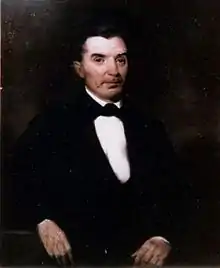Isaac Franklin | |
|---|---|
 Portrait of Franklin by W.B. Cooper | |
| Born | May 26, 1789 Sumner County, Tennessee, U.S. |
| Died | April 27, 1846 (aged 56) West Feliciana, Louisiana, U.S. |
| Nationality | American |
| Occupation(s) | Planter, slave trader |
| Spouse | Adelicia Hayes |
| Parent(s) | James Franklin Mary Lauderdale |
| Military career | |
| Allegiance | |
| Service/ | United States Army |
| Years of service | 1812 |
Isaac Franklin (May 26, 1789 – April 27, 1846) was an American slave trader and plantation owner. He was the co-founder of Franklin & Armfield, which became the largest slave trading firm in the United States. Based in Alexandria, Virginia, it also had offices in Natchez, Mississippi; New Orleans and other Louisiana cities.[1] Franklin owned a total of six plantations in Tennessee and Louisiana. His Fairvue plantation, in Gallatin, Sumner County, Tennessee, was formerly listed on the National Register of Historic Places.
By 1841, Franklin left slave trading and devoted his energy to the plantations and other property interests. At the age of 50, he married for the first time, to 22-year-old Adelicia Hayes of Nashville. None of their four children survived childhood.
In the late 19th century, his widow eventually sold the Louisiana plantations. In West Feliciana Parish, his former Angola and other plantations were bought by the state in 1901 and converted for use as Louisiana State Penitentiary, the largest maximum-security prison in the United States.
Early life
Isaac Franklin was born on May 26, 1789, at Pilot's Knob Plantation on Station Camp Creek in Sumner County, Tennessee.[2] His father James Franklin (1755-1825 or 1828) and grandfather Charles (1735-1769) both came from Baltimore, Maryland. James served in the Revolutionary War and was later listed by militia leader James Robertson as one of the "Immortal Seventy" who were granted one square mile or 640 acres (2.6 km2) each of land by the state of North Carolina for their service.[3] (North Carolina at the time claimed Tennessee as part of its territory to the west.)
Isaac's mother was Mary Lauderdale. James Franklin prospered in Tennessee—as each of his sons reached adulthood, he presented them with a horse, a bridle, and a pocket knife. When Isaac was twenty-one years old, he received his share and, according to tradition, used the knife to carve a ship miniature. He sold this to a friend for one dollar. Over the next fifteen years he made a fortune in slave trading.[3]
Career
Franklin took up slave trading in 1810, after the United States had prohibited the Atlantic Slave Trade. The invention of the cotton gin and removal of Native Americans from the Southeast stimulated the demand for enslaved African Americans to develop cotton lands in the Deep South.[1] After serving in the War of 1812, Franklin resumed the trade.[1]

In 1828 Franklin formed a partnership with his nephew John Armfield when Isaac's father James died and bequeathed land and slaves to him and his brother James.[1][4] They set up Franklin & Armfield in Alexandria, then part of the District of Columbia.
Between 1828 and 1837, Franklin & Armfield became "the largest slave trading firm" in the United States.[1] Franklin's main sales office was in Natchez, Mississippi; he also had offices in New Orleans, the major slave trading center in the South; St. Francisville, and Vidalia, Louisiana.[5]
Franklin and Armfield joked with each other in coded letters about the enslaved women they were raping. They each had a child with a woman they had enslaved, and sold their children.[6][7][8]
The firm owned six ships, including one called Isaac Franklin, that were outfitted to take enslaved men, women, and children from Alexandria coastwise to the Deep South.[1] The ships returned with cargoes of sugar, molasses, whiskey, and cotton.[1]

Franklin made his Tennessee plantation, "Fairvue," his home. Once Fairvue was finished, he turned toward Louisiana, where he purchased six plantations, named "Bellevue", "Killarney", "Lochlomond", "Angola", "Loango" and "Panola". In 1901, the land of four of the combined plantations was bought by the state and developed as Angola State Penitentiary.
Franklin also bought thousands of acres of land in Texas, as well as a turnpike, bank stock, and a third interest in the Nashville Race Course.[1] After 1835, his activity as a slave trader reduced as he became more involved in managing his plantation interests.[9] When he died in 1846, Franklin owned 10,000 acres (40 km2) of land in Louisiana and more than 600 enslaved people.[3]
Personal life
In 1839, at the age of fifty, he married socialite Adelicia Hayes (1817–1887),[10] the 22-year-old daughter of Oliver Bliss Hayes (1783-1858), a lawyer and a Presbyterian minister, and Sarah Clemmons Hightower (1795-1871).[11]
By the time of his marriage to Hayes, Franklin had fathered at least one child with an enslaved woman named Lucinda, whom he had been using as a sex slave for about five years.[9] Soon after this wedding, Franklin sold the enslaved woman and her child, whose fates are unknown.[9][7] Franklin and his wife Adelicia had four children: Victoria, Adelicia, Emma, and Julius Caesar. All died in early childhood.[12][11]
Upon his death in 1846, Franklin left his slave trading fortune, plantations, and slaves to his wife Adelicia. She later married again, and had Belmont Mansion and its estate built in 1853 in what was then country outside Nashville.[13] All of his children with Hayes died without heirs, so his only descendants are those of women he raped.[14]
Death and legacy
Isaac Franklin died on April 27, 1846, in West Feliciana Parish, Louisiana.[1][15] His corpse was preserved in alcohol and he was taken to Fairvue.[1]
By a will he made in 1841, Franklin made a bequest to endow a school or seminary at Fairvue. The will was the subject of protracted litigation by his Armfield, his nephew and former partner. [16]
His widow sold Fairvue to William Franklin[17] and remarried the following year.
She leased, and later in the 19th century sold, the Louisiana plantations to Samuel James, who leased convict labor (mostly black) from the state to work them. The state acquired the merged plantations under the name Angola in 1901; this land was used for the development of Angola Prison.[18]
See also
References
- 1 2 3 4 5 6 7 8 9 10 Gudmestad, Robert H. (Fall 2003). "The Troubled Legacy of Isaac Franklin: The Enterprise of Slave Trading". Tennessee Historical Quarterly. 62 (3): 193–217. JSTOR 42627764.
- ↑ The Historic Blue Grass Line. 1913. p. 78.
- 1 2 3 Kenneth C. Thomson, Jr., "Isaac Franklin was a Well-Liked Slave Trader," in Gallatin Examiner, Thurs. May 13, 1976.
- ↑ Ball, Edward (Nov 2015). "Retracing Slavery's Trail of Tears: America's Forgotten Migration – The Journeys of a Million African-Americans From the Tobacco South to the Cotton South". Smithsonian. Retrieved 18 Sep 2019.
- ↑ Wendell Holmes Stephenson, Isaac Franklin, Slave Trader and Planter (Louisiana State University Press 1938) at p. 4
- ↑ Schermerhorn, Calvin (2018). Unrequited Toil: A History of United States Slavery. Cambridge University Press. ISBN 9781108631709.
- 1 2 Hannah Natanson (14 Sep 2019). "They were once America's cruelest, richest slave traders. Why does no one know their names?". Washington Post. Retrieved April 20, 2021.
- ↑ Johnson, Walter (October 2008). The Chattel Principle: Internal Slave Trades in the Americas. Yale University Press. ISBN 978-0300129472.
- 1 2 3 Betsy Phillips (7 May 2015). "Isaac Franklin's money had a major influence on modern-day Nashville — despite the blood on it". Nashville Scene. Retrieved 15 Sep 2019.
- ↑ Wendell Holmes Stephenson (1938). Isaac Franklin: Slave Trader and Planter of the Old South, With Plantation Records. Louisiana State University Press. p. 52.
- 1 2 James A. Hoobler, Sarah Hunter Marks, Nashville: From the Collection of Carl and Otto Giers, Arcadia Publishing, 2000, p. 36
- ↑ Supreme Court, Texas (1883). "The Texas Reports: Cases Adjudged in the Supreme Court".
- ↑ History of Belmont Mansion, http://www.belmontmansion.com/history Archived 2017-03-12 at the Wayback Machine
- ↑ "They were once America's cruelest, richest slave traders. Why does no one know their names?". Macomb Daily. September 14, 2019.
- ↑ "ISAAC FRANKLIN". The Mississippi Free Trader. Natchez, Mississippi. October 17, 1846. p. 2. Retrieved November 3, 2017 – via Newspapers.com.
- ↑ Franklin v. Armfield, 2 Sneed (TN) 305, 34 Tenn. 305 (1854)
- ↑ Gudmestad, Robert H. (2003-11-07). A Troublesome Commerce: The Transformation of the Interstate Slave Trade. LSU Press. ISBN 9780807129227.
- ↑ Peter Kolchin, American Slavery, New York: Penguin Books, 1995, p. 97